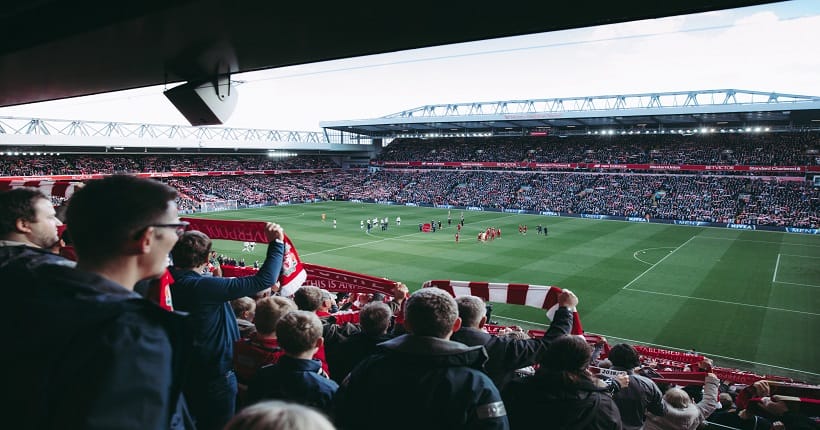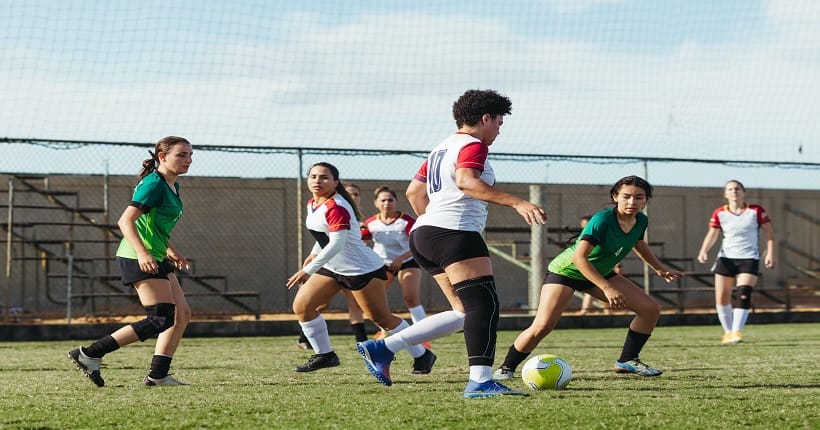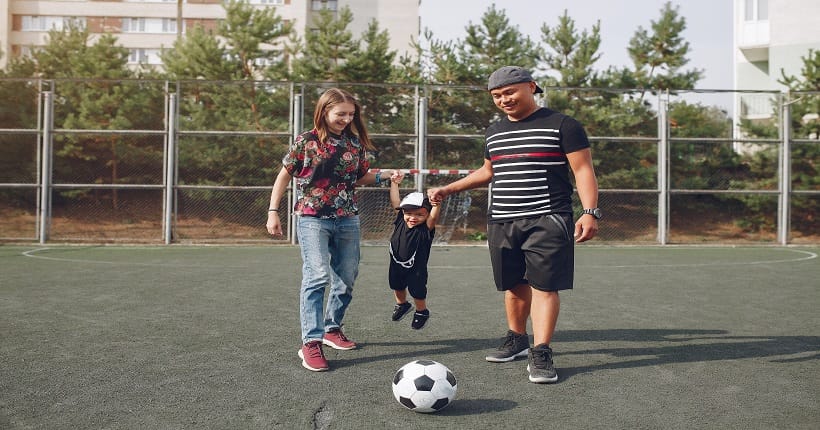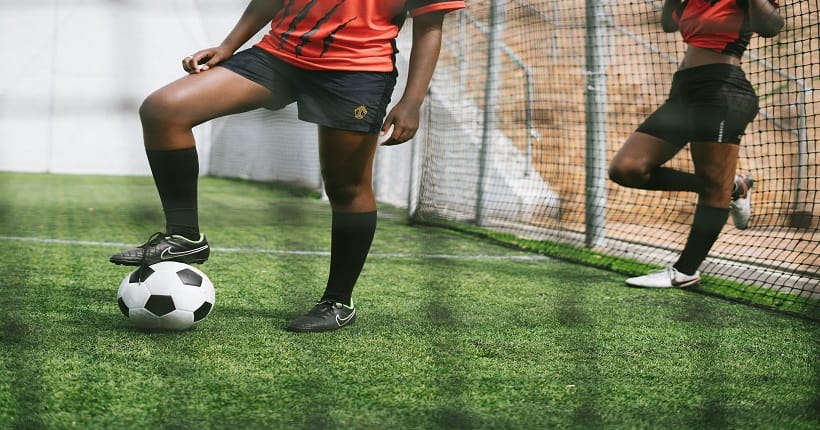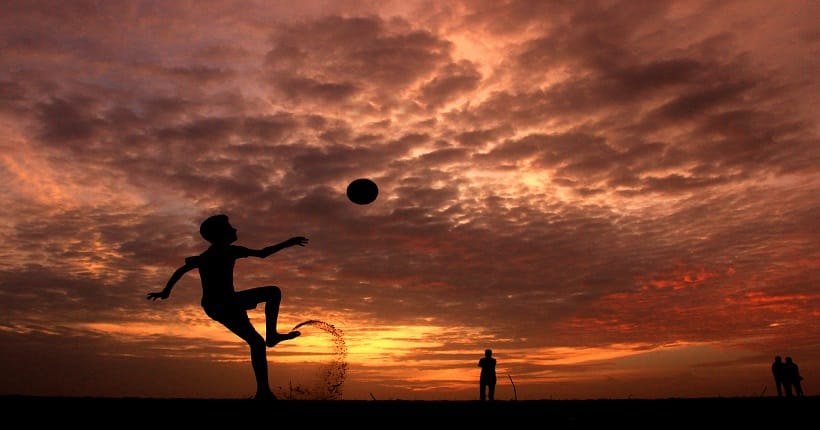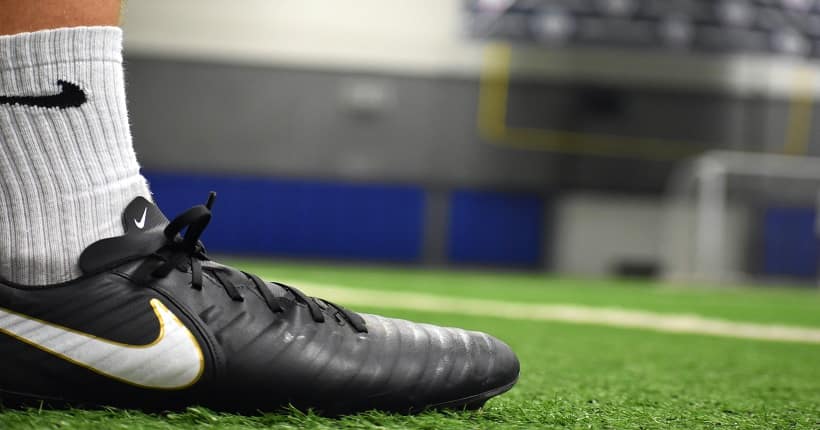What Is The Difference Between Soccer And Baseball Cleats?
Soccer cleats are designed with thinner soles and more prominent studs for better traction on grass, while baseball cleats have thicker soles with fewer and smaller studs for stability on dirt and grass. Soccer and baseball cleats differ in their design and functionality.
Soccer cleats are specifically designed for use on softer, grass surfaces and feature thinner soles for enhanced flexibility and control. These cleats also have more prominent studs or spikes that provide better traction and grip on the grass. On the other hand, baseball cleats are designed for use on both dirt and grass surfaces and have thicker soles to provide stability and support.
They typically have fewer and smaller studs that are strategically placed to prevent slippage and ensure a firm grip during running, sliding, and catching actions. Understanding the differences between soccer and baseball cleats is essential to optimize performance and prevent injuries in the respective sports.
Key Design Differences Between Soccer And Baseball Cleats
When it comes to choosing the right footwear for sports like soccer and baseball, one must consider the specific design differences of their respective cleats. Understanding these differences can greatly impact performance and prevent potential injuries. In this article, we will explore the key design variations between soccer and baseball cleats, focusing on the type of studs or cleats used, cleat patterns and configuration, and the design and shape of the outsole.
Type Of Studs Or Cleats Used
In terms of the type of studs or cleats used, soccer and baseball cleats differ significantly. Soccer cleats typically feature shorter studs or small molded blades. These studs are designed to provide optimal traction on various playing surfaces, including grass, turf, and even artificial pitches. The shorter length allows players to make quick changes in direction, maintain stability, and enhance their overall agility on the field.
On the other hand, baseball cleats tend to have longer studs or spikes. These cleats are designed to dig into the dirt on the baseball diamond, offering better traction and grip for running, stopping, and making quick movements. The length of the spikes ensures that players can maintain their footing on the loose and slippery dirt surface, allowing them to perform at their best during key moments of the game.
Cleat Patterns And Configuration
Another major design difference lies in the specific cleat patterns and configuration used in soccer and baseball cleats. Soccer cleats often feature various patterns, such as conical, bladed, or a combination of both. These patterns are strategically placed to enhance grip and stability while minimizing the risk of slippage. The configuration of the cleat patterns allows soccer players to have better control when dribbling, passing, and shooting the ball.
On the contrary, baseball cleats typically have a more uniform pattern that primarily consists of individual spikes or cleats. This pattern is specifically designed to penetrate and grip the soil on the baseball field, ensuring players have the necessary traction to sprint, slide, and maneuver around bases. The configuration of these cleats provides stability to prevent players from losing footing and allows them to execute precise movements during the game.
Design And Shape Of The Outsole
The design and shape of the outsole play a crucial role in differentiating soccer and baseball cleats. Soccer cleats generally have a more flexible outsole that allows for smoother foot movements and quick changes in direction. This flexibility enhances the player’s agility and promotes better ball control. Additionally, soccer cleats often feature a lower-profile outsole, providing a closer feel to the ground for improved stability and responsiveness.
On the other hand, baseball cleats tend to have a more rigid outsole to withstand the rough playing conditions on the diamond. The sturdier construction ensures durability and protects players’ feet from potential injuries caused by sharp or sudden movements. Furthermore, the outsole of baseball cleats is typically more elevated, providing added ankle support and stability when running, sliding, or pivoting on the uneven terrain.
Performance Differences Of Soccer And Baseball Cleats
Choosing the right footwear for your specific sport is crucial. When it comes to soccer and baseball, one key difference lies in the cleats worn by players. Soccer cleats and baseball cleats are designed to optimize performance on different playing surfaces and accommodate the unique demands of each sport. In this section, we will explore the performance differences between soccer and baseball cleats, focusing on traction and grip on different playing surfaces, maneuverability and agility, and stability and support for quick movements.
Traction And Grip On Different Playing Surfaces
Traction plays a vital role in both soccer and baseball as rapid changes in direction and quick acceleration are common in both sports. However, the playing surfaces in soccer and baseball differ greatly, and as a result, the design of the cleats varies.
In soccer, players encounter a variety of surfaces such as grass, artificial turf, and sometimes even muddy conditions. Soccer cleats typically feature multiple studs or blades on the outsole, designed to provide optimal traction on grass while preventing the accumulation of mud. These cleats allow soccer players to make quick cuts, changes in direction, and maintain balance on slippery surfaces.
On the other hand, baseball is predominantly played on dirt or artificial turf surfaces. Baseball cleats feature metal or plastic spikes strategically positioned on the outsole. These spikes dig into the dirt or grip the artificial turf, enhancing traction while sprinting or making sharp turns during the game. The design of baseball cleats helps players maintain stability on uneven surfaces and prevent slipping while running the bases or fielding.
Maneuverability And Agility
In both soccer and baseball, maneuverability and agility are key to success on the field. The design of the cleats plays a significant role in enhancing these aspects.
Soccer cleats prioritize maneuverability and quickness, as players have to dribble the ball, change direction rapidly, and evade opponents. These cleats are lightweight and often feature a low-cut design, allowing for greater freedom of movement in the ankle. The construction of soccer cleats emphasizes flexibility to enable natural foot motion and unhindered agility.
Baseball cleats, while also focusing on agility, prioritize stability and support due to the dynamic movements involved in the sport. Baseball players must have the ability to accelerate, decelerate, and make sudden stops. As a result, baseball cleats are typically designed with a higher ankle collar, providing additional support and reducing the risk of ankle injuries. The construction of these cleats emphasizes stability and durability to withstand the rigorous movements during gameplay.
Stability And Support For Quick Movements
Both soccer and baseball require quick movements and rapid changes in direction, necessitating stability and support from the cleats worn by the players.
Soccer cleats offer stability by having a snug fit. They are designed with a lower profile to keep the player’s center of gravity close to the ground, improving balance and reducing the risk of ankle injuries. Additionally, some soccer cleats feature a supportive midsole and cushioning to absorb impact during intense movements, adding further stability and comfort.
Baseball cleats, as mentioned earlier, provide stability and support through their higher ankle collar design. This design helps secure the ankle and provide additional support while running bases or making quick lateral movements. Baseball cleats also offer features like supportive insoles and cushioning to absorb shock and enhance stability.
It’s important to note that while there are some similarities in the performance aspects of soccer and baseball cleats, the specific design differences address the unique demands of each sport. By understanding these differences, athletes can make informed choices that optimize their performance on the field.
How Material And Construction Differ In Soccer And Baseball Cleats
When it comes to soccer and baseball cleats, there are several key differences to consider when choosing the right footwear for your sport. One of the main factors that sets soccer and baseball cleats apart is the materials used in their construction. From the upper materials to the comfort and durability aspects, each sport has unique requirements that affect the design and performance of their respective cleats.
Upper Materials Used In Soccer And Baseball Cleats
In soccer cleats, the upper materials are designed to enhance touch and ball control. They are typically made of synthetic materials such as synthetic leather or microfiber, which provide a snug fit and a lightweight feel. The synthetic materials used in soccer cleats are also more resistant to water absorption, keeping the cleats light even in wet conditions.
On the other hand, baseball cleats have a different focus when it comes to their upper materials. They are usually made of genuine leather to provide optimal durability and flexibility. The leather used in baseball cleats allows for better protection and support for the foot during quick lateral movements and pivots on the diamond.
Comfort And Fit Considerations
Comfort and fit are crucial aspects to consider in any sports footwear. In soccer cleats, the focus is on providing a snug and secure fit to enhance agility and control on the field. The materials used in soccer cleats are often engineered to mold to the shape of the foot, providing a customized fit. Additionally, soccer cleats usually have a low-profile design to ensure a light and responsive feel.
Baseball cleats, on the other hand, prioritize comfort and support as players spend extended periods on their feet. They often feature cushioning and padding in the midsole and collar areas to provide extra comfort during long games. The construction of baseball cleats also emphasizes ankle support and stability, with higher ankle collars and additional straps or lacing systems.
Durability And Longevity Of Cleats
When it comes to durability and longevity, soccer and baseball cleats differ due to the physical demands of each sport. Soccer cleats are designed with lightweight materials to optimize speed and agility. While these materials may sacrifice some durability, they are built to withstand the rigors of intense playing conditions. The synthetic materials used in soccer cleats are also less prone to wear and tear, allowing for longer-lasting performance.
On the other hand, baseball cleats require excellent durability due to the nature of the sport. With frequent sliding, running, and pivoting on rough surfaces like dirt and grass, baseball cleats need to withstand heavy use. The genuine leather upper materials and reinforced toe boxes in baseball cleats provide the necessary durability to endure the demands of the game.
The material and construction of soccer and baseball cleats have significant differences to meet the specific needs of each sport. From the upper materials to the comfort and durability aspects, understanding these distinctions is crucial in choosing the right cleats for optimal performance on the field or diamond.
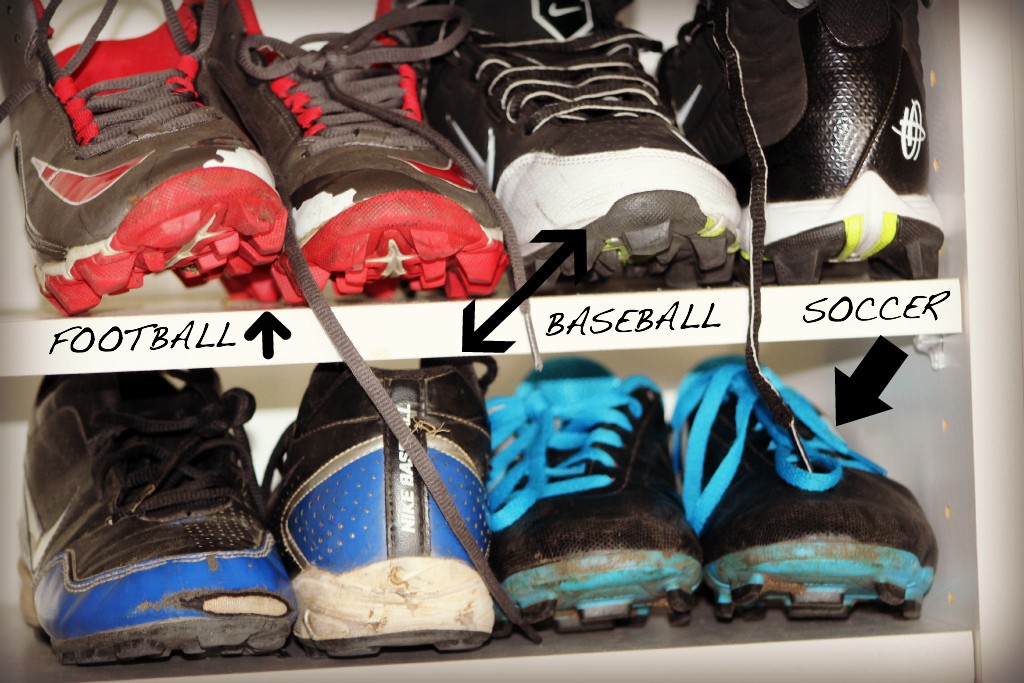
Credit: ilovetowatchyouplay.com
Game-specific Features In Soccer Cleats
When it comes to choosing the right footwear for any sport, understanding the game-specific features is crucial. In the case of soccer cleats, these features are designed to optimize performance on the field, providing players with the necessary tools to excel. Let’s explore some of the key game-specific features found in soccer cleats that set them apart from their baseball counterparts.
Ball Control And Touch Enhancement Features
One of the most important aspects of soccer is the ability to control the ball with precision and finesse. Soccer cleats are specially designed to enhance ball control and touch. These cleats typically feature a thinner and more textured upper material, which allows for better grip and manipulation of the ball. The texture helps to create friction between the foot and the ball, giving players better control during dribbling, passing, and shooting.
In addition to the textured material, some soccer cleats include innovative features such as off-center lacing, which provides a larger striking surface for the ball. This design element helps to enhance accuracy and power when shooting or passing the ball. The combination of textured uppers and off-center lacing ensures that players have optimal control over the ball, allowing for improved performance on the field.
Lightweight Construction For Speed
In soccer, speed and agility are vital attributes that can make a significant difference to a player’s performance. Soccer cleats are designed with lightweight construction in mind, enabling players to move swiftly across the field with ease. The materials used in the construction of soccer cleats are lightweight yet durable, ensuring that players can maintain their speed and agility while also being protected on the playing surface.
By reducing unnecessary weight, soccer cleats allow for faster acceleration and quick changes in direction, giving players a competitive edge. The lightweight construction not only enhances speed but also reduces the risk of fatigue, allowing players to perform at their best throughout the game.
Ankle Support Options For Injury Prevention
Soccer involves rapid movements, sudden changes in direction, and close contact with other players, which can lead to ankle injuries if not properly supported. Understanding the importance of ankle stability, soccer cleats often offer a variety of ankle support options to protect players from potential injuries.
Some soccer cleats feature a low-cut design, providing maximum flexibility and freedom of movement. This design is suitable for players who prioritize agility and need the freedom to make quick turns and movements on the field. On the other hand, high-top soccer cleats offer additional ankle support, reducing the risk of sprains, twists, and other ankle-related injuries. These cleats are particularly favored by players who require extra stability or have a history of ankle problems.
By prioritizing ankle support in their designs, soccer cleats help players minimize the risk of injuries and stay on the field, enjoying an uninterrupted game.
Game-specific Features In Baseball Cleats
When it comes to choosing the right footwear for a sport, it’s important to consider the game-specific features that can enhance performance and protect players from potential injuries. In the case of baseball cleats, these specialized shoes are equipped with various features that cater to the specific demands of the game. Let’s delve into the different game-specific features found in baseball cleats:
Impact Absorption Features For Running And Jumping
Running and jumping are essential movements in baseball, and the right pair of cleats can greatly impact a player’s performance. Baseball cleats are designed with specific impact absorption features that cushion the feet against the constant jarring motions experienced during running and jumping.
One of the key components that contribute to impact absorption is the midsole of the cleats. Made from high-quality materials, such as EVA foam or polyurethane, the midsole acts as a shock absorber, attenuating the impact and reducing stress on the foot. This not only provides enhanced comfort but also minimizes the risk of injuries like stress fractures or joint pain.
Ankle Stability And Support For Lateral Movements
In baseball, players often engage in lateral movements that require quick changes in direction to field the ball or steal a base. Hence, ankle stability and support are crucial factors to consider when choosing baseball cleats.
To cater to these needs, baseball cleats are designed with features like a supportive ankle collar, padding, and high-top design. These elements work together to provide excellent ankle stability, preventing any unnecessary twists or sprains during sudden direction changes. The added support allows players to move with agility and confidence, enabling them to react swiftly to game situations.
Toe Protection Features For Sliding And Kicking
Baseball involves several actions like sliding into bases and kicking during pitching or batting. These actions can subject a player’s feet to tremendous stress and increase the risk of toe injuries. Therefore, baseball cleats come equipped with toe protection features to safeguard against such situations.
The toe box of baseball cleats is reinforced with durable materials such as rubber or composite materials. This reinforced toe cap provides extra protection while sliding or kicking, minimizing the chances of injury or discomfort. These protective features give players the confidence to perform at their best without worrying about potential toe injuries.
Factors To Consider In Selecting Soccer Cleats
Choosing the right pair of soccer cleats is essential for any player looking to elevate their game. With a wide range of options available in the market, it’s important to consider certain factors that can greatly impact your performance on the field. From the playing surface to your position-specific requirements, as well as your style preferences and budget considerations, each element plays a significant role in determining which soccer cleats are the best fit for you. Let’s explore these factors in more detail:
Playing Surface And Field Conditions
Understanding the playing surface and field conditions is crucial in determining the type of soccer cleats that will offer you optimal traction and stability. Different surfaces have varying levels of grip, which can influence your ability to maneuver on the field efficiently. There are three main types of playing surfaces:
- Natural Grass: This is the most common type of playing surface, often found in outdoor soccer fields. It provides excellent stability and traction, making firm-ground (FG) soccer cleats the ideal choice. These cleats feature molded studs that dig into the grass, providing stability and preventing slippage.
- Artificial Turf: Artificial turf fields are becoming increasingly popular due to their durability and low maintenance. For this type of surface, turf soccer cleats are recommended. These cleats have shorter, rubberized studs that provide adequate grip without damaging the turf.
- Indoor Courts: Indoor soccer is typically played on artificial surfaces, such as rubber or carpet-like materials. For indoor games, indoor soccer shoes or flats are the go-to option. These shoes have a non-marking rubber sole that offers grip and maneuverability on the court.
Position-specific Requirements
Different positions on the soccer field require different features in cleats to enhance performance and prevent injuries. Here are some position-specific considerations to keep in mind:
| Position | Key Cleat Features |
|---|---|
| Forward/Striker | – Lightweight for speed – Agility and quick direction changes |
| Midfielder | – Versatility for both offensive and defensive play – Good ball control |
| Defender | – Durability for tackling and defensive maneuvers – Good ankle support |
| Goalkeeper | – Excellent traction and stability – Toe protection for dives and saves |
Style Preferences And Budget Considerations
Your personal style preferences and budget are also essential factors when selecting soccer cleats. While style considerations may vary from player to player, it’s important to prioritize comfort, fit, and functionality over aesthetics alone. Additionally, budget constraints can play a role in determining the range of options available to you. Remember, investing in a quality pair of soccer cleats can greatly impact your performance and help prevent injuries in the long run.
By taking into account the playing surface and field conditions, position-specific requirements, and your personal style preferences and budget considerations, you can make an informed decision when selecting soccer cleats. Ensuring the right fit will give you the confidence to perform your best, while also keeping you comfortable and protected on the field.
Factors To Consider In Selecting Baseball Cleats
In order to excel in baseball, it is crucial to have the right equipment, including the right pair of baseball cleats. Baseball cleats are specifically designed to provide traction and stability on the field, allowing players to perform at their best. However, with so many options available, it can be overwhelming to choose the perfect pair. Here are three key factors to consider in selecting baseball cleats:
Playing Position And Field Condition Requirements
One of the first factors to consider when choosing baseball cleats is your playing position and the condition of the field you will be playing on. Different positions require different levels of traction and support. For example, pitchers and catchers typically benefit from cleats with more ankle support to enhance stability during quick movements. On the other hand, outfielders may prefer cleats with metal spikes for better traction on grassy fields. In addition, understanding the condition of the field, whether it is grass, turf, or dirt, is essential as different cleat designs offer varying levels of grip on different surfaces.
Fit And Comfort For Long Periods Of Wear
Baseball games and practices can last for several hours, so it is important to select cleats that provide both an optimal fit and maximum comfort. Ill-fitting cleats can cause discomfort, blisters, and even potential injuries. Look for cleats that offer a snug fit, providing stability and preventing your foot from sliding inside the shoe during quick movements. Additionally, consider the level of cushioning and padding in the cleats to ensure long-lasting comfort and support throughout the game.
Additional Features For Specific Baseball Techniques
Depending on your playing style and techniques, certain additional features in baseball cleats can significantly enhance your performance. For example, pitchers may benefit from cleats with reinforced toe caps to protect against toe drag during the pitching motion. Some cleats also have specialized traction patterns that aid in quick turns and explosive movements on the field. Additionally, cleats with removable or interchangeable studs offer versatility, allowing players to adapt to different field conditions and personal preferences.
By considering these factors – playing position and field condition requirements, fit and comfort, and additional features for specific baseball techniques – you can make an informed decision when selecting baseball cleats. Remember, the right pair of cleats can greatly impact your performance on the field and ultimately contribute to your success in the game of baseball.
Frequently Asked Questions On What Is The Difference Between Soccer And Baseball Cleats?
Can I Wear Baseball Cleats For Soccer?
No, you should not wear baseball cleats for soccer. Baseball cleats have different spikes and may not provide the proper traction and support needed for soccer. It is best to wear soccer-specific cleats to ensure safety and optimal performance on the field.
How Can You Tell The Difference Between Baseball And Soccer Cleats?
Baseball cleats usually have a metal spike or molded rubber sole to provide traction on grass and dirt. Soccer cleats have a patterned stud configuration for traction on turf or grass. Look at the sole to determine the type of cleat.
What’s The Difference Between Soccer Cleats And Softball Cleats?
Soccer cleats are designed for playing soccer, while softball cleats are for playing softball. Soccer cleats have studs or blades for traction on grass, while softball cleats have molded spikes for traction on dirt and grass. The main difference lies in the type of traction needed for each sport.
Can You Wear Softball Cleats For Soccer?
No, you can’t wear softball cleats for soccer as they are designed differently. Soccer cleats have studs that provide better traction on grass, while softball cleats have flat soles for better grip on the dirt. It’s important to wear the appropriate shoes for each sport to optimize performance and prevent injury.
Are Soccer And Baseball Cleats The Same?
Soccer and baseball cleats differ in design and traction, catering to the specific demands of each sport.
What Are The Key Features Of Soccer Cleats?
Soccer cleats offer lightweight construction, low-cut designs, and specialized stud patterns for agility and grip.
Conclusion
To sum up, soccer cleats and baseball cleats have key differences that cater to the unique demands of each sport. While soccer cleats prioritize traction on grass and agility, baseball cleats prioritize stability on dirt and additional ankle support. Understanding their distinctions helps athletes choose the right footwear for their specific needs, thereby enhancing their performance on the field.

